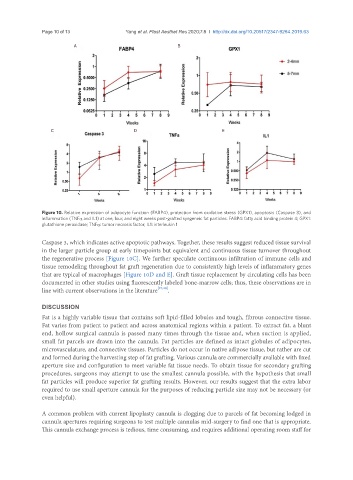Page 94 - Read Online
P. 94
Page 10 of 13 Yang et al. Plast Aesthet Res 2020;7:8 I http://dx.doi.org/10.20517/2347-9264.2019.63
A B
C D E
Figure 10. Relative expression of adipocyte function (FABP4), protection from oxidative stress (GPX1), apoptosis (Caspase 3), and
inflammation (TNFα and IL1) at one, four, and eight weeks post-grafted syngeneic fat particles. FABP4: fatty acid binding protein 4; GPX1:
glutathione peroxidase; TNFα: tumor necrosis factor; IL1: interleukin 1
Caspase 3, which indicates active apoptotic pathways. Together, these results suggest reduced tissue survival
in the larger particle group at early timepoints but equivalent and continuous tissue turnover throughout
the regenerative process [Figure 10C]. We further speculate continuous infiltration of immune cells and
tissue remodeling throughout fat graft regeneration due to consistently high levels of inflammatory genes
that are typical of macrophages [Figure 10D and E]. Graft tissue replacement by circulating cells has been
documented in other studies using fluorescently labeled bone-marrow cells; thus, these observations are in
line with current observations in the literature [27,28] .
DISCUSSION
Fat is a highly variable tissue that contains soft lipid-filled lobules and tough, fibrous connective tissue.
Fat varies from patient to patient and across anatomical regions within a patient. To extract fat, a blunt
end, hollow surgical cannula is passed many times through the tissue and, when suction is applied,
small fat parcels are drawn into the cannula. Fat particles are defined as intact globules of adipocytes,
microvasculature, and connective tissues. Particles do not occur in native adipose tissue, but rather are cut
and formed during the harvesting step of fat grafting. Various cannula are commercially available with fixed
aperture size and configuration to meet variable fat tissue needs. To obtain tissue for secondary grafting
procedures, surgeons may attempt to use the smallest cannula possible, with the hypothesis that small
fat particles will produce superior fat grafting results. However, our results suggest that the extra labor
required to use small aperture cannula for the purposes of reducing particle size may not be necessary (or
even helpful).
A common problem with current lipoplasty cannula is clogging due to parcels of fat becoming lodged in
cannula apertures requiring surgeons to test multiple cannulas mid-surgery to find one that is appropriate.
This cannula exchange process is tedious, time consuming, and requires additional operating room staff for

